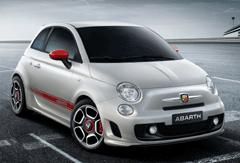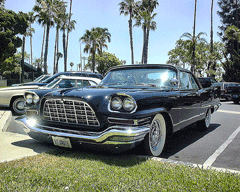Italian-American Fuel Efficiency
Air Date: Week of May 1, 2009

The new Fiat 500 could be the first Fiat built in North America.
As Chrysler reorganizes in bankruptcy, it also seals a partnership with Italian car-maker Fiat. LA Times automotive columnist Dan Neil talks with host Steve Curwood about what the new partnership will mean for greening the Chrysler fleet and what the future may holds for other U.S. auto companies.
Transcript
ANNOUNCER: Support for Living on Earth comes from the National Science Foundation and Stonyfield Farm.
[THEME]
CURWOOD: From the Jennifer and Ted Stanley studios in Somerville, Massachusetts, this is Living on Earth. I’m Steve Curwood.
YOUNG: And I’m Jeff Young in Washington.
President Obama came into office pledging to save jobs and create millions of new green ones. And now he could be doing both by putting the public treasury behind a bankruptcy reorganization of Chrysler Motors.

Chrysler’s 300C of 1957, an ancestor of the muscle car. Chrysler was one of the first car companies in the United States. (Photo: Matthew Brown)
OBAMA: It’s a partnership that will give Chrysler not only a chance to survive but to thrive in a global auto industry. Fiat has demonstrated that it can build the clean fuel-efficient cars that are the future of this industry. And as part of this agreement, Fiat has already agreed to transfer billions of dollars in cutting edge technology to Chrysler to help them do the same. Fiat has also committed to working with Chrysler to build new fuel-efficient cars and engines right here in America.
CURWOOD: This is a no-money-down deal for Fiat, but Fiat must keep at least 90 percent of Chrysler’s workforce. The deal could also be a model for how the government might use tax dollars to rescue GM.
Dan Neil, automotive writer for the Los Angeles Times, joins us. Now, Dan, you’re in California, that’s a state that’s on track to limit global warming gases from cars, and other states are set to follow suit. Now, how is that key to the Chrysler Fiat business plan?
NEIL: Well that requirement would raise the emission standards for autos in California up to thirty or forty percent by 2016, which is a dramatic increase in efficiency for automobiles. In that case – yes, Chrysler would be far better positioned, assuming it can survive long enough to rebadge and otherwise reengineer these Fiat platforms that are intended to remodel the show rooms of Chrysler.

Dan Neil is an automotive columnist for the LA Times.
CURWOOD: Next up is General Motors, GM, they’ve got another few weeks to work out a deal, but it looks like at the end of the day that company will be thirty percent owned by the union. How green will GM become?
NEIL: Well, a lot depends on, I think - the California ruling will make a big difference in product planning going forward. If they want to stay in business they’ll have to meet these higher standards, obviously. So they will be at least that green. One of the ironies of this whole process is that they’re having to sell off some of the very things that they’re going to need to survive. For example, they’re going to get rid of Opel. Well, Opel makes really great small cars with really great precision engines. They’re gonna have to get rid of Saab. They’re gonna get rid of Saturn. Saturn really helps GM’s CAFE bottom line. And then, of course, there’s the Volt which is a range extended battery electric hybrid that GM has been building and sort of trumpeting for a couple of years now. The Volt will be a money loser for quite a while after it comes to market. They want to sell it for $40,000. It probably costs $80,000 to build. So, that’s also not a source of profitability in the short term. It’s going to be very, very difficult for GM to become greener and at the same time become, as they say, a viable business entity.
CURWOOD: You say that GM is gonna loose money on the Volt. Well Toyota, of course, lost a lot of money on the Prius. It cost them about $60,000 or $80,000 to make the first Priuses and they were selling it in the thirties, they were losing a lot of money.
NEIL: Right.
CURWOOD: What is it that the federal government needs to be prepared to do if its gonna see GM and Chrysler and perhaps even have to help Ford through this transition to greener vehicles.
NEIL: Well, the big thing they could do is to stabilize the price of gasoline. That would be a big help. The next thing they could do is they could help with battery technology, which, in fact, the Obama administration has done. They put over $2 billion into advanced battery technology for automobiles. The third thing they could do – they have done – is they are finally offering some clarity on carbon emissions from automobiles. You know, one of the things that was so frustrating watching this process in the past decade is that the car companies were fighting against these regulations, but they really suffered from the uncertainty.

The Fiat 500 with its retro look could be the first Fiat built in North America.
NEIL: Ah well, the ultimate villain in all of this is the quarterly profit report. Japanese companies take a much longer view of things. The Prius was a long-term investment. Same deal with Honda. Honda invested in hybrid technology long before it was cool, long before it was profitable. This constant near term thinking and planning led General Motors for example in 2006 to double down on SUVs and big truck design. And that left them, when the crisis came, at a disadvantage because when people stopped buying these trucks and SUVs in great numbers, their sales fell through the floor.
CURWOOD: What are the odds that GM and Chrysler can catch up with Honda and Toyota in their quality?
NEIL: The world will have to turn over on its axis before that happens. It’s going to be a very big challenge. Now when we’re talking about vastly smaller, vastly leaner, vastly more agile companies than General Motors, Chrysler or Ford – yeah, there’s no reason. There are actually more smart people in Detroit than there are in the car business in Tokyo. It is a mistake to think that American carmakers are somehow inherently inferior. They’re not. They’ve been hamstrung by a system and a corporate culture. This bankruptcy, this purifying fire, that these companies may be going through now – I think will unleash a great deal of innovation and they will rise again. But it will be very challenging in the short term.
CURWOOD: So, perhaps in the future you’ll be buying – what will we call it – a Fi-ysler or a Chri-at?
NEIL: I like that. You better trademark those. Those are good.
CURWOOD: Dan Neil is an automotive columnist for the Los Angeles Times. Dan - thanks so much.
NEIL: Okay. You’re welcome, Steve.
Links
Living on Earth wants to hear from you!
Living on Earth
62 Calef Highway, Suite 212
Lee, NH 03861
Telephone: 617-287-4121
E-mail: comments@loe.org
Newsletter [Click here]
Donate to Living on Earth!
Living on Earth is an independent media program and relies entirely on contributions from listeners and institutions supporting public service. Please donate now to preserve an independent environmental voice.
NewsletterLiving on Earth offers a weekly delivery of the show's rundown to your mailbox. Sign up for our newsletter today!
 Sailors For The Sea: Be the change you want to sea.
Sailors For The Sea: Be the change you want to sea.
 The Grantham Foundation for the Protection of the Environment: Committed to protecting and improving the health of the global environment.
The Grantham Foundation for the Protection of the Environment: Committed to protecting and improving the health of the global environment.
 Contribute to Living on Earth and receive, as our gift to you, an archival print of one of Mark Seth Lender's extraordinary wildlife photographs. Follow the link to see Mark's current collection of photographs.
Contribute to Living on Earth and receive, as our gift to you, an archival print of one of Mark Seth Lender's extraordinary wildlife photographs. Follow the link to see Mark's current collection of photographs.
 Buy a signed copy of Mark Seth Lender's book Smeagull the Seagull & support Living on Earth
Buy a signed copy of Mark Seth Lender's book Smeagull the Seagull & support Living on Earth

